Food Insecurity Common Among Patients With ASCVD
The burden of food insecurity is even higher in vulnerable subgroups, such as some minority groups and the uninsured.

Approximately one in seven patients with atherosclerotic cardiovascular disease (ASCVD) experience some form of food insecurity, and the prevalence is even higher among the most-vulnerable subgroups, according to the results of a new study.
Investigators say the social determinants of food insecurity and their relationship with health outcomes can no longer be ignored by physicians and professional societies.
“Food insecurity is definitely underrecognized, at least within our own cardiovascular community,” senior investigator Khurram Nasir, MD, MPH (Houston Methodist DeBakey Heart and Vascular Center, TX), told TCTMD. “It’s mostly related to the patient’s socioeconomic status, where access is limited to adequate food. We found that there is a very strong relationship with other social determinants of health. In general, if you have a patient with ASCVD, one of [every] seven families would be food insecure. We’re talking about people with low and very low food security.”
Within the broader population, some subgroups are particularly vulnerable, said Nasir. For example, more than half of ASCVD patients with a grouping of other high-risk sociodemographic characteristics—female sex, low incomes, lack of insurance, non-Hispanic Black or Hispanic race/ethnicity, separated/divorced/widowed status, and age 18 to 64 years—reported food insecurity.
“It goes hand in hand,” said Nasir. “There are many people who have four, or five, or six of these high-risk characteristics. If you have more than five of these risk factors, one in two families are food insecure. This is literally every other family, and it has significant implications.”
Trade-offs—Medication or Food?
Published August 13, 2021, in the Journal of the American Heart Association, with lead author Shiwani Mahajan, MBBS (Yale New Haven Hospital, CT), the study included 190,113 adults who participated in the National Health Interview Survey between 2013 and 2018. In all, 18,442 of these adults reported an ASCVD diagnosis. Among them, 14.6% reported food insecurity compared with 9.1% of those without ASCVD (OR 1.24; 95% CI 1.14-1.35).
For those with ASCVD, food insecurity was more common among younger individuals, with 25.9% and 22.9% of those ages 18 to 39 and 40 to 64 years, respectively, reporting food insecurity compared with 7.8% of those ages 65 years and older. Food insecurity was also more common in women than in men (17.6% vs 12.2%; P < 0.001). Additionally, 30.1% and 23.4% of non-Hispanic Black and Hispanic patients with ASCVD, respectively, reported food insecurity compared with 10.7% of non-Hispanic white adults. Those with poor/low incomes and private or no health insurance, as well as those who were divorced, separated, or widowed, also had higher rates of food insecurity.
The researchers then looked at the cumulative effects of these observed high-risk characteristics on food insecurity. For ASCVD patients with one high-risk characteristic, 2.2% of these individuals reported food insecurity. In contrast, of those with two, three, four, five, and six high-risk characteristics, 6.4%, 15.7%, 27.9%, 42.6%, and 53.7%, respectively, reported food insecurity.
In previous studies, Nasir’s group has shown that one in eight patients with ASCVD skip or cut back on medications because of the high cost of prescriptions, while half report significant financial strain from their medical bills. They’ve also shown that one-third of ASCVD patients forgo getting the flu vaccine, with younger patients, those without insurance, those with lower incomes, and those who identify as non-Hispanic Black more likely to remain unvaccinated. These studies all show that a large number of patients with ASCVD are facing trade-offs between affording food, medications, and other necessities, say researchers.
“We’re observing the same phenomena,” said Nasir. “We’re trying to at least educate policy leaders, healthcare leaders, the community, and the medical community to show that social determinants of health have a significant overarching role in identifying the vulnerable cohorts who might not have access to vaccines, who might have difficulty paying bills, who have difficulty affording their care, and who might have food insecurity. We need a better way to screen for these social determinants of health so that we might be able to tailor our interventions.”
For physicians, if they screen patients and identify those at the highest risk of food insecurity, they could then help connect them with social programs to help alleviate the burden. Nasir noted that the Supplemental Nutrition Assistance Program (SNAP) is one such program and there are studies showing that use of SNAP can reduce the likelihood of food insecurity, as well as lead to fewer sick days and doctor visits plus less downstream resource utilization.
Michael O’Riordan is the Managing Editor for TCTMD. He completed his undergraduate degrees at Queen’s University in Kingston, ON, and…
Read Full BioSources
Mahajan S, Grandhi GR, Valero-Elizondo J, et al. Scope and social determinants of food insecurity among adults with atherosclerotic cardiovascular disease in the United States. J Am Heart Assoc. 2021;10:e020028.
Disclosures
- Nasir reports serving on advisory boards for Amgen, Novartis, and The Medicines Company.





Comments